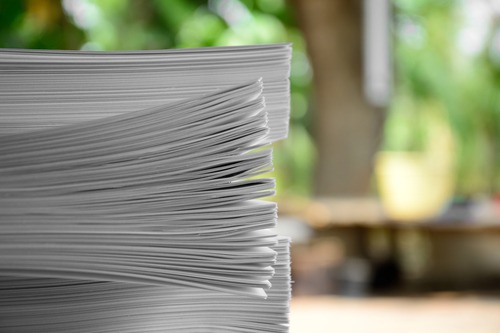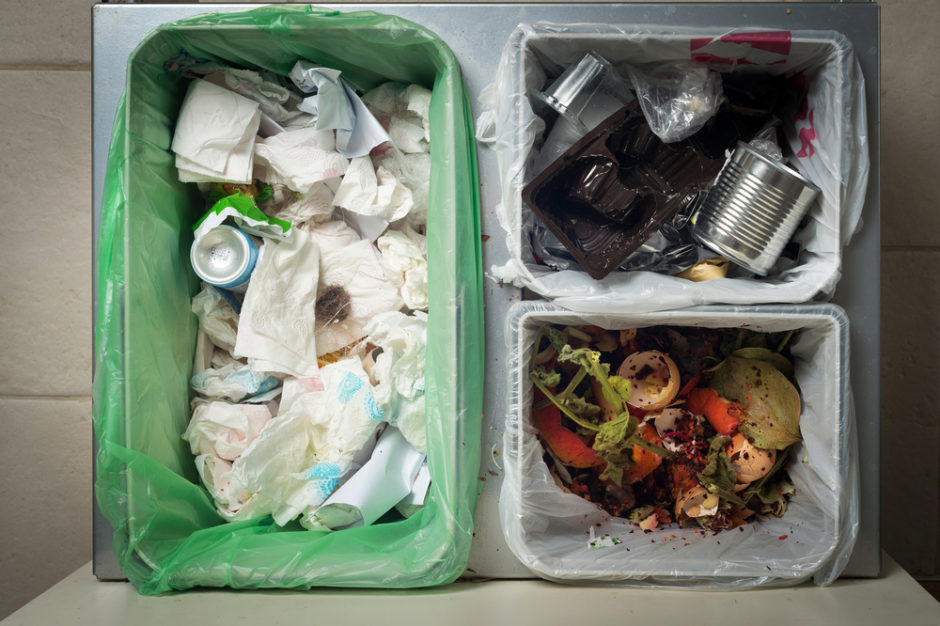Source: earth911.com
Published: June 9, 2016
Madeleine Somerville
It’s a testament to our increased awareness of waste management and environmental issues that we now often have several options at hand when it comes to getting rid of things that have outlived their purpose — reuse, recycling, composting, repurposing and upcycling all come to mind. Batteries, bottles, orange peels — all can find their way into a recycling bin or a compost pile and, happily, avoid the landfill altogether. This is a welcome advancement, especially as waste levels continue to increase and garbage pollution becomes an increasingly worrisome issue.
So excluding refusal to consume from the mix altogether are there instances when composting trumps, say, recycling? Let’s take a look.
All that paper

At the end of the day, both recycling and composting have a cost, an impact, and a trade-off. Image Credit: wissanustock / Shutterstock
Paper products in particular routinely make up a sizable chunk of total waste material.
“According to the EPA, Americans generated about 254 million tons of trash in 2013. The agency goes on to say that the United States ‘recovered about 67 percent (5.7 million tons) of newspaper/mechanical in 2013.”
That’s absolutely staggering especially when you consider that there are not one but two better options for used paper than languishing in a dump somewhere.
Yes, when it comes to disposing of paper or cardboard, you can both recycle or compost. Either one would be preferable to contributing to that 16% of landfill waste, but how do you choose? Which is best for the environment, both in terms of resources used and overall benefit?
When you choose to recycle a piece of paper, you reintroduce it into the production stream and eliminate the need to cut down more virgin trees to produce paper. Paper products are incredibly wasteful and despite technology’s early promise of a paperless world, the world we live in is anything but. Our paper consumption continues to grow, with North America consuming the most paper in the world, year after year. It’s a resource-intensive endeavor, turning trees into crisp sheets of stark white paper. Each piece of standard letter-sized paper requires 10 liters of water to produce, not to mention the millions of acres of land deforested for this purpose.
Recycling helps mitigate these effects, according to the website; The World Counts, “Recycling 1 ton of paper saves around 682.5 gallons of oil, 26,500 liters of water and 17 trees”.
We can conserve a staggering amount of resources simply by taking paper out of the trash and putting it into the recycling bin, instead.
Paper, pulp, process, paper
When it’s recycled, paper is broken down into a pulp and processed into new paper. It comes out ahead when compared to creating paper from trees, but it’s not a zero waste endeavor by any means, and some question whether recycling paper is really worth the effort.
An article by Slate examining the issue reminds us that recycling, particularly paper recycling, is not all sunshine and rainbows.
“…The recycling process creates an inky sludge that presents a disposal challenge. Many common inks contain metals such as chromium, zinc, and lead, which can seep into water supplies.”
Of course, manufacturing paper from virgin trees has its risks, too, and even when taking into account these environmental roadblocks, most of those who have made in-depth examinations of the issue conclude that recycling does indeed result in a net benefit to the environment.
Try composting instead?

What if we skipped recycling altogether and simply started composting our paper waste instead? Image Credit: Graham Corney / Shutterstock
So, although recycling saves resources compared to producing virgin paper, it also takes resources of its own. What if we skipped recycling altogether and simply started composting our paper waste instead?
A good compost pile relies on a balanced mix of both green and brown waste. Nitrogen-rich green waste is made up of things like fruit peels and vegetable trimmings, while carbon-rich brown waste is comprised of things like leaves. Paper products- and particularly unbleached cardboard – counts in the brown waste column and can be a welcome addition to your compost bin, preventing it from getting moldy, stinky, or slimy.
By composting your paper instead of recycling it, you could completely eliminate the resources needed to break it down and manufacture it back into fresh paper. No recycling bins, no trucks to carry it to the recycling plant, no machinery or sludge or chemical processing agents. Just paper breaking down into its component parts and then fertilizing your garden next year, helping your tomatoes grow.
It seems simple enough, but the process we skirt by avoiding the recycling bin also contribute to one of the reasons that composting might not win here. By composting paper, we remove from the recycling stream. In doing so it’s true that we conserve recycling resources but we also now increase the need to deplete forests to make up the difference and create new paper. Our voracious need for paper products means that raw material has to come from somewhere, and reducing the amount of paper being recycled may simply mean an increased demand for new deforestation.
When looked at through this lens of supply and demand, recycling paper is almost always better than composting. Yes, it takes resources, but far fewer than it does to produce new. And removing paper from the production stream in a large scale way by composting it instead of recycling it may end up doing more harm than good.
Exceptions to the rule
The one exception to this is if the paper is soiled in any way — think a child’s art project or a grease-stained pizza box — in these cases the paper is unfit for recycling and including it may taint an entire batch of recycling and render it useless for processing. Tear the pizza box into shreds and add it to your compost pile, and remember that when it comes to those pint-sized masterpieces, white glue, dried pasta and masking tape are all suitable for composting. (Not that you’d ever be getting rid of those lovely gifts, though, right?)
At the end of the day, both recycling and composting have a cost, an impact, and a trade-off.
- The only solution which reliably comes out ahead with a clean slate in this regard is simply reducing the amount of paper you use in the first place.
- Remember to print only when necessary and print double-sided whenever possible.
- Always buy 100% post-consumer recycled paper products whenever you can — I mean what’s the good of all that recycling if no one wants to buy the finished product?
68 million trees are chopped down to make paper each and every year in the United States. Please think about your own paper use and how to reduce it first, before recycling (or composting, for that matter).
Feature image credit: KaliAntye / Shutterstock

